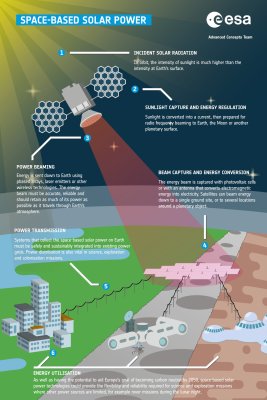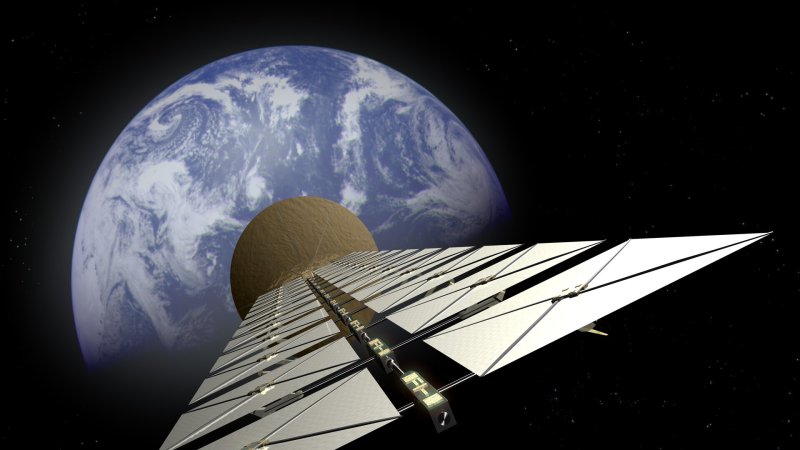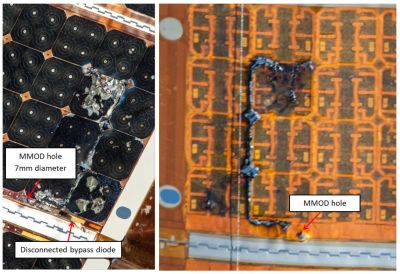Space-Based Solar Power: Folly Or Stroke Of Genius?

The Sun always shines in space, unless a pesky planet gets in the way. That’s more or less the essential thought behind space-based solar power (SBSP) as newly pitched by ESA’s director general, Josef Aschbacher on Twitter. Rather than putting photovoltatic solar panels on the Earth’s surface which has this annoying property of constantly rotating said panels away from the Sun during what is commonly referred to as ‘night’, the panels would be put stationary in space, unaffected by the Earth’s rotation and weather.
Although a simple idea, it necessitates the solving of a number of problems. The obvious first question is how to get these panels up in space, hundreds of kilometers from the Earth’s surface, to create a structure many times larger than the International Space Station. The next question is how to get the power back to Earth, followed by questions about safety, maintenance, transfer losses and the inevitable economics.
With organizations ranging from NASA to China’s Academy for Space Technology (CAST), to US institutions and others involved in SBSP projects, it would seem that these problems are at the very least deemed to be solvable. This raises the question of how ESA’s most recent proposal fits into this picture. Will Europe soon be powered from orbital solar panel arrays?
Asking The Right Questions

ESA’s announcement doesn’t come out of nowhere, but follows the completion of two studies on the topic that were commissioned at the beginning of this year. According to these studies it would be possible to provide competitively priced electricity to European homes and businesses by 2040, with as big selling that this could alleviate the need for large-scale grid utility storage solutions.
As we have covered previously, grid-level storage is going to be under pressure to bridge dips in solar electricity production. SBSP satellites would however be beaming energy down to Earth ideally 24/7, giving them similar performance to a nuclear power plant at well over 90% capacity factor. This is also noted on the ESA overview page for SBSP and specifically their proposed SOLARIS project.
In a nutshell, the lack of atmosphere makes space-based solar significantly more efficient than Earth-based solar, with a projected SBSP satellite requiring about 600,000 panels stretching over a kilometer across to generate about 2 GW, akin to a nuclear plant with two reactors.
For the ground-based receiving station – for the microwave or laser-based radiation being beamed down from the SBSP satellite – a footprint of about ten times that (~10 km) would be needed. Although this would make the ground-based footprint smaller than that of the roughly six million PV solar panels plus overcapacity, it would take significantly more space than a comparable coal, gas or nuclear power plant.
The questions here seem to condense down to two primary questions, assuming that fossil fuels are not an option:
- Is SBSP competitive with a well-run nuclear power program as in e.g. South Korea and China?
- Is SBSP competitive with a 100% renewable grid backed fully by storage?
A Political Minefield
It is an unfortunate reality that energy policy is heavily politicized. When it comes to ESA’s SOLARIS pitch, this could be regarded as a way to get funding approved for Europe’s own heavy-lift rocket program that could compete with something on the level of SpaceX’s Starship.
This is a point raised by Eric Berger in his analysis, which also references Elon Musk’s strong dismissal of SBSP, and a 2019 analysis by physicist Casey Handmer of SBSP. Handmer addresses the other elephant in the room, of transmission efficiency and overall system losses. The power from the solar panels has to be converted to microwaves for transmission, transmitted to the ground station, which captures what makes it through the atmosphere using a gigantic metal mesh antenna, where it has to be converted again to a form usable for the electrical grid.

Assuming a generouss 80% conversion efficiency of the PV electricity to microwaves, this would also require the satellite to somehow deal with 400 MW of waste heat for a 2 GW array in an environment where heat shedding is notoriously difficult. For the microwave transmission itself through the Earth’s atmosphere, losses would be incurred as well through attenuation and reflection by water and other elements (Karmakar et al., 2010).
The power that would ultimately be received on the ground would thus be anything but constant, but rather fluctuate with factors like the amount of water vapor between the satellite and ground station antenna. Of the 2 GW originally captured, 1.8 GW would be converted to microwaves, which by the estimate of Dr. Handmer would be no more than 40%, leaving us with 720 MW, which after further ground station and transmission losses is likely to amount to between 500 MW – 700 MW, depending on the weather.
At this point we find ourselves confronted with the uncomfortable question about the logistics of getting these satellites into space, assembled, and above all funded.
Too Cheap To Measure

diode is disconnected due to MMOD impact. (Credit: Hyde et al., 2019)
As fast as launch prices have been dropping ever since companies like SpaceX threw down the commercial launch gauntlet, getting a kilogram of anything up into orbit is still expensive, even with SpaceX’s Starship flying regularly. Its launch cost would be likely about $10 million per flight, or $100 per kilogram. The weight of one of these satellites would be far more than the entire ISS, including its PV panels, supporting structure, microwave generator and transmission antenna plus additional control and communication hardware.
The cost of one of these satellites plus ground station would be in the order of billions, all to generate the equivalent of what a large concentrated solar plant (CSP) or small nuclear plant could generate today. Even assuming launch costs were to drop to the $10/kg suggested by Elon Musk, it would not fix the thermal issues and transmission losses. Nor would it address the unsolved problem of assembly and maintenance.
If the ISS were launched today with a Starship, it’d still need in-orbit assembly using humans and/or a robotic arm. Assembling the largest in-orbit structure in human history presents many open questions. The ESA-commissioned Frazer-Nash report states that they expect in-orbit assembly to take anywhere between four to six years, per satellite.
Even assuming that optimistic estimate, this compares to the five to six years construction time observed (Lovering et al., 2016) with nuclear plants, e.g. during France’s 1970s build-out or today’s nuclear power plant construction in China, with even the massively delayed and over budget Olkiluoto 3 EPR reactor at about €8.5 billion for 1.6 GW output reaching an levelized cost of electricity of €30/MWh. Modern reactors also have a rated lifespan of 80+ years, which further helps to amortize the large up-front costs.
 This leads to the next point, namely that of maintenance. Although SBSP satellites and PV solar arrays are safely outside the bounds of Earth’s atmosphere and its weather, they are subject to space weather, including space debris, as well as micrometeorites. The ISS has seen its share of damage to both its central structures and its solar panels. Together with the increased radiation exposure in space, this means that space solar arrays would degrade much more rapidly than ground-based arrays, and possibly be taken out by an unlucky hit on a crucial part of the satellite.
This leads to the next point, namely that of maintenance. Although SBSP satellites and PV solar arrays are safely outside the bounds of Earth’s atmosphere and its weather, they are subject to space weather, including space debris, as well as micrometeorites. The ISS has seen its share of damage to both its central structures and its solar panels. Together with the increased radiation exposure in space, this means that space solar arrays would degrade much more rapidly than ground-based arrays, and possibly be taken out by an unlucky hit on a crucial part of the satellite.
The expected lifespan of such a satellite can be estimated based on data gleaned from the ISS in particular. Unlike Earth-based solar arrays, the arrays on spacecraft use gallium-arsenide instead of silicon. These do not degrade as quickly in the harsh environment of space, even if they’re still vulnerable to a kinetic strike. This necessity to radiation-proof the PV solar panels also means that they’re much more costly than the mass-produced PV solar panels commonly used on Earth.
With in-orbit repair for these SBSP satellites, here too we run into the problem that no such thing has ever been attempted, beyond maintenance work on space stations like the ISS, using astronauts and robotic arms, and the service missions on the Hubble Space Telescope. These were heroic endeavors.
A Hard Case
As a potentially much cheaper alternative to SBSP, one can imagine something like space-based mirrors. These would not be as high-tech as orbital PV solar arrays beaming microwaves to the ground, but could be as simple as self-unfolding mirror satellites with ion thrusters to maintain position. These could reflect sunlight to a PV solar array on Earth, for example, costing only a fraction and using mostly proven technology.
Back in 2019, China had announced that it would ‘most likely’ launch its own SBSP satellites into orbit between 2021 and 2025, with a MW-level satellite being launched by 2030. So far there has been a severe lack of updates. The distinct feeling here is that perhaps SBSP is more of a national prestige thing, even more so than space stations. From massive orbital construction to a range of other ‘never done before’ items, a successful SBSP project would perhaps be the grandest national power flex imaginable.
Meanwhile it seems that the best strategy to power our societies is to keep building nuclear plants alongside solar and wind, none of which requires us to invent whole new technologies and industries from scratch.
Post a Comment